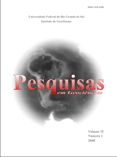Urban Street Pollutants
DOI:
https://doi.org/10.22456/1807-9806.17932Palavras-chave:
Suspended sediments, metals, urban dustsResumo
The sediments carried by runoff water are an important part of this process because their presence in the bodies of water not only cause sedimentation problems but, mainly, they contaminate the water due to the presence of the pollutants found associated with sediments. The urban subwatershed under study is located in the metropolitan region of Porto Alegre city, Brazil. This paper aims to present the relation between pollutants on the street sediments and in suspended sediment sampled in the river. The collections of suspended sediment samples begun in the end of 2003 and finished in the end of 2006. Collections of urban dust samples (47 samples per km²) were taken in the main diffuse sources of the urban environment, represented by paved and non-paved streets, beyond the area with remaining vegetation, in some points of the bed river and in its margins. During these analyses, it was studied 29 samples of fluvial suspended sediments. The elements selected for this study are some of the most frequently found in high concentrations in urban areas (Zn, Pb and Cu). The results suggest it is occurring a high enrichment of the local sediment with these metals. The concentrations of these elements vary temporally during storms due the input of road runoff containing elevated concentrations of elements associated with vehicular traffic and other anthropogenic activities. In general, they have their most concentrations on the streets but they are carried to the channel during the storms.Downloads
Referências
Cardoso, A. R., Poleto, C. & Merten, G. H. 2006. Ocupação do Espaço Urbano e a Maximização de suas Fontes de Sedimentos. In: Merten, G. H.; Poleto, C.; Borges, A. L. O.(eds.). ENES Simpósio Nacional de Engenharia deSedimentos, 7, Porto Alegre, ABRH. p. 37-50.
Charlesworth, S. M., Everett, M., McCarthy, R., Ordóñez, A. &Miguel, E. 2003. A Comparative Study of Heavy MetalConcentration and Distribution in Deposited Street Dusts in aLarge and a Small Urban Area: Birmingham and Conventry,West Midlands, UK. Environment International, 29(1):563-573.
CONAMA. Conselho Nacional do Meio Ambiente. 2004.Resolução nº 344, de 25 de março de 2004. Ministério doMeio Ambiente. Site: http://www.mma.gov.br/port/conama/res/res04/res34404.xml
Dahl, A. L. 2005. Comparison of Direct and Operational Methods for Probing Metal Bioavailability and Speciationin Aquatic Systems. 273p. Thesis, Northwestern University,Evanston, Illinois, USA
De Carlo, E. H., Beltran, V. L. & Tomlinson, M. S. 2004.Composition of Water and Suspended Sediment in Streams of Urbanizad Subtropical Watersheds in Hawaii. Applied Geochemistry, 19(1): 1011-1037.
De Miguel, E., Llamas, J. F., Chacón, E., Berg, T., Larssen, S.,Royset, O. & Vadset, M. 1997. Origin and Patterns ofDistribution of Trace Elements in Street Dust: Unleaded Petrol and Urban Lead. Atmosphery Environment, 31(1): 2733-2740.
Guéguen, C., Dominik, J., Pardos, M., Benninghoff, C. &Thomas, R. L. 2000. Partition of Metals in the Vistula Riverand in Effluents from Sewage Treatment Plants in the Regionof Cracow (Poland). Lakes & Reservoirs: Research and Management, 5(1): 59-66.
Horowitz, A. J. 1991. A Primer on Sediment-Trace Element Chemistry. 2 ed. Chelsea, EUA, Lewis Publishers, 136p.
Horowitz, A. J., Elrick, K. A. & Smith, J. J. 2001. Estimating Suspended Sediment and Trace Element Fluxes in LargeRiver Basins: Methodological Considerations as Applied to the NASQAN Programme. Hydrological Processes, 15(1): 1107-1132.7
Mudroch, A., Azcue, J. & Mudroch, P. 1997. Manual ofPhysico-Chemical Analysis of Aquatic Sediments. Florida,EUA, CRC Press, 287p.
Poleto, C., Merten, G. H. & Silveira, A. L. L. 2005. Socio-Economic Impacts on Fluvial System an Urban Watershed inSouthern Brazil. In: INTERNATIONAL CONFERENCEON URBAN DRAINAGE, 10, Copenhagen, Dinamarca.
Poleto, C. & Gonçalves, G. R. 2006. Qualidade das Amostras eValores de Referência. In: Poleto, C.; Merten, G. H. (Eds.).Qualidade dos Sedimentos. Porto Alegre: ABRH. p. 237-277.
Simonovski, J., Owens, C. & Birch, G. 2003. Heavy Metals inSediments of the Upper Hawkesbury-Nepean River. Austra-lian Geographical Studies, 2(41): 196-207.
Taylor, K. 2007. Urban Environments. In: Perry, C.; Taylor, K. (Eds.). Environmental Sedimentology. UK, BlackwellPublishing Ltd., 441p.
U.S. Geological Survey - USGS. 2003. Effects of Urban Development on Floods. Fact Sheet FS-076-03. Available:http://water.usgs.gov
Vdovic, N., Billon, G., Gabelle, C. & Potdevin, J. L. 2006.Remobilization of Metals from Slag and Polluted Sediments(Case Study: The Canal of the Deûle River, NorthernFrance). Environmental Pollution, 2(41): 359-369.
Downloads
Publicado
Como Citar
Edição
Seção
Licença

Este trabalho está licenciado sob uma licença Creative Commons Attribution-NonCommercial-NoDerivatives 4.0 International License.



